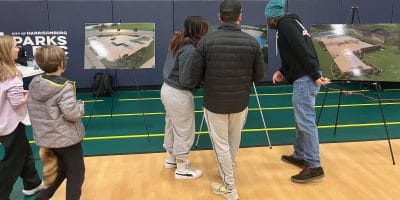A contributed perspectives piece by Boris Ozuna, Jonathan McRay, Eric Olson-Getty, Paloma Saucedo, and Teresa Hinkley, members of the FUEGO Coalition
The Citizen recently published an article about Harrisonburg’s school resource officer program. As the title states, school resource officers (and police and prisons at large) are under scrutiny right now, so the article seeks to describe how Harrisonburg City Schools work with the Police Department. FUEGO is currently participating in a task force to determine whether or not police officers should be present in schools and, if so, what their roles should be. One of our members wrote a community perspective piece for the Citizen on this process. We see this recent article as another opportunity to clarify a different perspective on safety, justice, and healing for our schools and society.
As a coalition of human beings committed to igniting the heat of deep transformation, we’re grateful for journalism that tells complex stories and shares important information to shape our actions here at home! We need to hear voices from diverse experiences, from various stances, to nuance our own views, sometimes to compassionately change our minds and sometimes to fortify them so we’re better prepared to respond when those views advocate more violence, more punishment, or more limitations to civil liberties as the solution to social injustice or the conflicts in our daily lives.
The Citizen’s SRO article begins with the perspective of police, ends with the voice of the police department’s restorative justice coordinator, and while using the language of “juveniles,” the actual language of juveniles, the voices of youth themselves, was absent from the story. Sadly, parents and school employees serving in the task force declined to comment for this article, which may also be true of any youth invited to share. Additionally, the empathic lens of the story favors the experience of SROs. As we previously said, hearing these stories is crucial for accurate and inclusive accounts! The Citizen’s article appropriately noted the various forms SROs take, the tasks they do, and the genuine relationships they can have with the schools and youth. The debate about the place of SROs runs a whole range. Several national organizations – such as the National Association of School Psychologists and the National PTA – support keeping SROs in schools, but they insist on a distinction between general police and school resource officers. They believe it is “wholly inappropriate and dangerous” to have police in schools who haven’t been carefully selected and trained to work with children and shouldn’t be involved in school discipline. Meanwhile, the American Federation of Teachers, an educators’ union with over 1.7 million members, states that school safety should be separated from the police, with safety personnel trained as peace officers through nonviolent resolution. They believe these peace officers shouldn’t also be police officers.
The interviewed Harrisonburg officers seem like genuine people who believe they have friendly relationships with some of the kids, who have been screened and trained. At least one officer indicated a mission to provide a positive example of policing so youth learn how to interact with police outside of schools. But the issue with SROs isn’t that some might be mean to kids. We think this focus confuses the problem. As school superintendent Michael Richards said, “[SROs] care about the kids . . . They’re good people. The problem is that you want to create in a school a climate of positive expectations, and armed police in schools creates, immediately, an environment of negative expectations.” The question is not whether individuals who wear uniforms can be caring people. We believe the more fundamental question is: do we need armed law enforcement inside our schools to keep children safe? Is the system that gives out the uniform the only, or even the best, way to provide protection, accountability, and justice for youth, and for everyone else?
The article confirmed FUEGO’s assumption that Black and brown students are disproportionately disciplined, suspended, or referred to law enforcement at HCPS. The data behind this reality comes from 2017-2018, so numbers from the entire history of SROs in Harrisonburg schools, especially the last ten years, would show whether this snapshot is a representative picture or an anomaly. Putting Harrisonburg in national context might give us a clue.
According to an article by the Healthy Schools Campaign, police officers in schools have more than doubled in the last twenty years, due in part to reactions to school shootings. The Southern Poverty Law Center notes that SROs have been around since the 1950s, but they dramatically increased in the mid-1990s because of racist fears about juvenile “super-predators,” despite the fact that teen crime and violence was declining. The U.S. Department of Education Office for Civil Rights reports that 42% of high schools have SROs, while 51% of schools with high Black and Latino enrollment have SROs. Nationwide, Black students are over 2 times more likely than white students to be arrested in schools, however arrest might be defined. Harrisonburg’s statistics seem to fit a larger pattern in the United States.
The statements from police officers and the police department’s restorative justice practitioner downplay the power schools give to law enforcement in its MOU, the intimidation experienced by students, the harm inflicted by arrest even if handcuffs are not involved, and the message given to the general student body that they could be subject to arrest, incarceration, or worse at any moment. The school-to-prison pipeline is also a “road filled with multiple checkpoints,” especially for students of color with disabilities, like the downward spiral of mental health from the trauma of increased suspensions, arrests, and the labels that often accompany them. While students are arrested (handcuffed or not), they don’t have a lawyer present and law enforcement may use any information against them or against anyone related to the alleged crime or offense. Are these students read their rights if they’re under arrest, or are they told the distinction between being detained and being arrested? Do we want to put students on roads filled with checkpoints like a military occupation?
We believe this road runs against the pathway of Restorative Justice. Restorative Justice is not about how nicely we can arrest children, nor about how friendly an individual police officer can be. Restorative Justice emphasizes healing and accountability to repair harm through respect, responsibility, and relationship. Instead of asking what law or school rule was broken, who broke it, and what punishment they deserve, Restorative Justice asks what happened, who has been affected or harmed, what is needed to make things right, who could be involved in meeting those needs, and how can we keep this from happening again? That means Restorative Justice questions power imbalances, both institutionally and socially. It questions and replaces the passivity of punishment with the action of accountability. Police presence in schools invites punishment, and quickly.
This brings us back to our fundamental question: do we need armed guards in schools? For many, this might depend on what the alternative routes would be. Those who argue in favor of the road of SROs (and police and prisons more broadly) might argue that the alternative is nothing, and therefore we would all be less safe without uniforms, badges, and guns. But what if there are other ways? What would some of those paths look like? They might look like highly-trained violence de-escalators such as the Newark Community Street Team that hires, trains, and deploys trauma-informed violence interrupters and outreach workers, including those who have been formerly incarcerated or involved in drug trade. They might look like the Dignity in Schools Campaign’s school, state, and federal policy recommendations for ending the regular presence of law enforcement in schools, or like Chicago’s Community Organizing and Family Issues guide for parents to advocate for restorative justice. They could look like the student-led campaign in Wake County, North Carolina, to replace SROs with a Peacebuilder Program, citing the example of a middle school in Oakland, CA, that reduced its suspension rate by 75% and expulsions and violent fights down to zero after 16 weeks of their own Peacebuilder Program.
If we’re going to replace SROs with something else, or rather somethings else, we’ll need more education and perhaps career-retraining. We’ll need more participation and more responsibility from all of us. In fact, we’ll need to practice something like democracy in our daily lives and not just every few years at the voting booth. That way, teachers and administrators, parents and students, won’t need to depend on the threat of arrest because we will have the skills and support we need to keep everyone safe.










